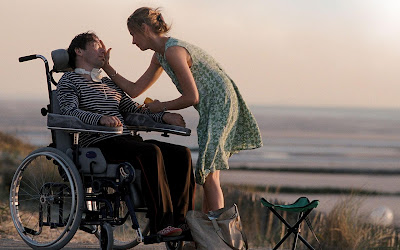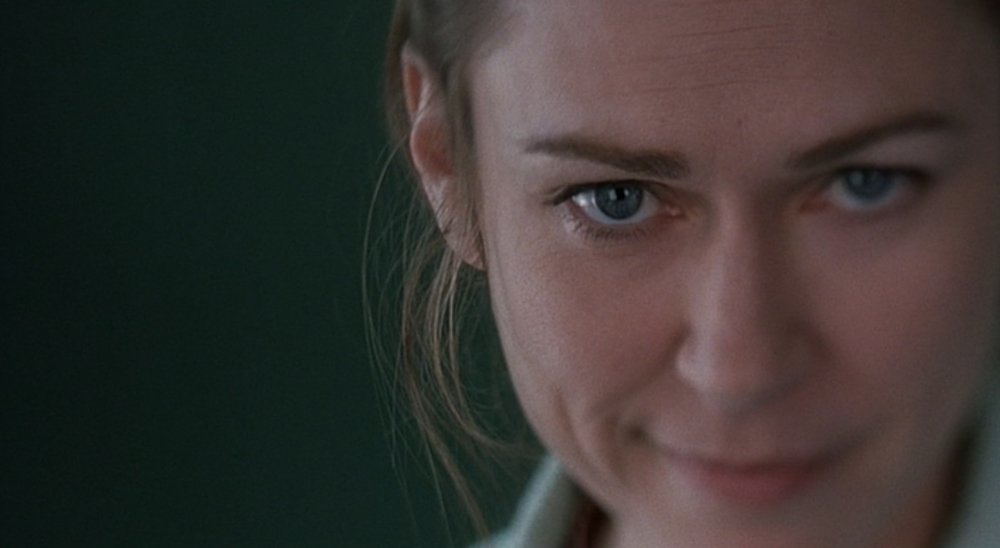Even though I consider myself a movie goer or viewer, I feel
that after this class has ended that I have learned so much more about film and
film making. Something that I should mention is that I’ve never heard of the
genre Film Noir, and I have to thank Billy Wilder’s film Double Indemnity (1944) for giving me a better understanding of its
style and meaning. Although the beginning may have given away, an aspect of
this film is figuring out who exactly the protagonist is, and this will keep
you wanting to watch. So of course I’m a sucker when it comes to mysteries and
thrillers, and this is one film that kept me wondering what exactly happened
and why it took place.
Fred MacMurray, Edward G. Robinson, and Barbara Stanwyck. Double Indemnity (1944).
Julian Schnabel film The Diving Bell and the Butterfly (2007) impressed with not only the directing of the film, but also the cinematography. Cinematographer Janusz Kaminski was able to catch realism of Jean-Dominique Bauby’s (played by Mathieu Amalric) new life struggle of being physically handicapped, and the struggle learning how to communicate with one eye. In doing so with a majority of the fillm, Kaminski is restricted to Bauby’s point of view through his left eye. An underrated detail about this film, but is compatible with Kaminski’s camera work is Mathieu Amalric’s voice-over narration where we get more insight of the story and blunt opinions of Bauby’s character. What I admire about this film is how though Bauby’s (a real life successful magazine editor) had a great set-back physically, he knew that he had to tell his story. In other words, the message of the Bauby is we could sit around depress and let our setbacks defeat us, or we could resist and fight it and keep moving forward.
Mathieu Amalric and Mari-Josée Croze. The Diving Bell and the Butterfly (2007).
Now I’m going to get a lot of heat when I confess and say
that I’ve never seen Quentin Tarantino’s film Pulp Fiction (1994). I’m not sure why I waited so long to watch
this film, but I think I would have enjoy it due to the amazing talent of the
actors. Now since Pulp Fiction is
widely known for how graphic, crude, and just plain out there, editing would be
involved. For instances continuity editing scene, where Mia (Uma Thurman)
almost overdoses on cocaine while waiting for Vincent Vega (John Travolta), but
the scene continues and ends with Mia getting an adrenaline shot. The editing also
helped with the order of the movie, that is in the case of the of Travolta’s
character. What I’m saying here is that the movie is out of order and give plenty
of backstories, however it makes it a one of kind. The last thing that I’ve
enjoy about Tarantino’s film is, like Alfred Hitchcock, he makes cameos in his
own film. I like how (in a way) with his cameo he explains to Jules Winnfield
(Samuel L. Jackson) how he needs to makes better decisions with his life, by
also not messing up other people’s life as well. This film impacted my me on
how I know that I made wise decisions, mostly with staying out of trouble and
that is thank to large part of Samuel L. Jackson’s character. I feel that for
not viewing this film all this time, made the wait and anticipation worth it.
John Travolta, Samuel L. Jackson, Tim Roth, and Amanda Plummer. Pulp Fiction (1994)
There are several films that I would recommend for people to watch and the first would be Alfred Hitchcock’s Psycho (1960). Although the acting in this movie is worth noting, the two aspects on the film’s story that stood out to me are the lighting and directing (cinematography). This is one of those movie I enjoy watching during October not just for the horror and slasher moment, but for its darkness and shock value as well. The lighting in this movie does make a shift from the beginning to a third into the film and I feel that it is foreshadowing that an event bigger and darker is coming. Now it’s going to be typical, but the shower scene was an iconic moment in cinematic history. Hitchcock put a lot of emphasis on this scene shooting a variety of angles, showing close-ups Marion Crane’s (Janet Leigh) face or mouth when she is screaming to the blood that is being drained, and the audience get a motif of the knife stabbing into Crane’s body. Ever since I’ve first saw this film, I felt that without films like this we would not have other films like John Carpenter’s Halloween (1978).
Janet Leigh and Mother (?). Psycho (1960)
There are two reasons why people should watch Some Like It Hot (1959). The first (and
I’m going to sound superficial) would be Marilyn Monroe, and this would be the
go-to film people need to see her in. Second and most importantly is the comedy
involving the film. So with comedy comes a lot of content and form. An example
of content that I always enjoy is the run-on joke throughout the film with Joe
(Tony Curtis) and Gerald (Jack Lemmon); Type-O. In the case other, there were
several scenes that satisfied comedy with its form. The best example would have
to be switching montage of Joe and Sugar (Monroe) alone and having a romantic
evening, which then shows Gerald and Osgood (Joe E. Brown) on their evening
date dancing away. In this moment, you can’t help but laugh at what is happening
with these characters. My favorite part of this film is the message; nobody’s
perfect.
Marylin Monroe, Tony Curtis, Jack Lemmon, and Joe E. Brown. Some Like It Hot (1959).
Finally, that I would recommend for people
to watch Oliver Stone’s The Doors (1991).
Although it is not exactly my favorite movie, I always seem to be able to sit
back and enjoy this film, and I think that it follows my criteria for films. Not
to mention the overall composition of the film is intriguing. In my opinion I
feel that The Doors just perfectly
describes (or defines mise en scène; from the wardrobe, the time setting and settings,
background extras, and what make the film different is how Oliver Stone’s uses
sequences in the film. The first sequence that was of interest to me was when
the Jim Morrison (Val Kilmer) along with his bandmates and girlfriend Pamela
(Meg Ryan) go to the desert for an acid trip; and the theme was how they were
all feel and what they were thinking. The next scene that had a great sequence was
when they are San Francisco with the counterculture (Hippies) after making
their first record; the theme here is a celebration. On a random note, this
film got me to ignore my favorite band, The Beatles. That’s the kind of impression
this movie was able to leave on me.
Val Kilmer, Meg Ryan, Kyle MacLanchlan, Kevin Dillion, and Frank Whaley. The Doors (1991).











